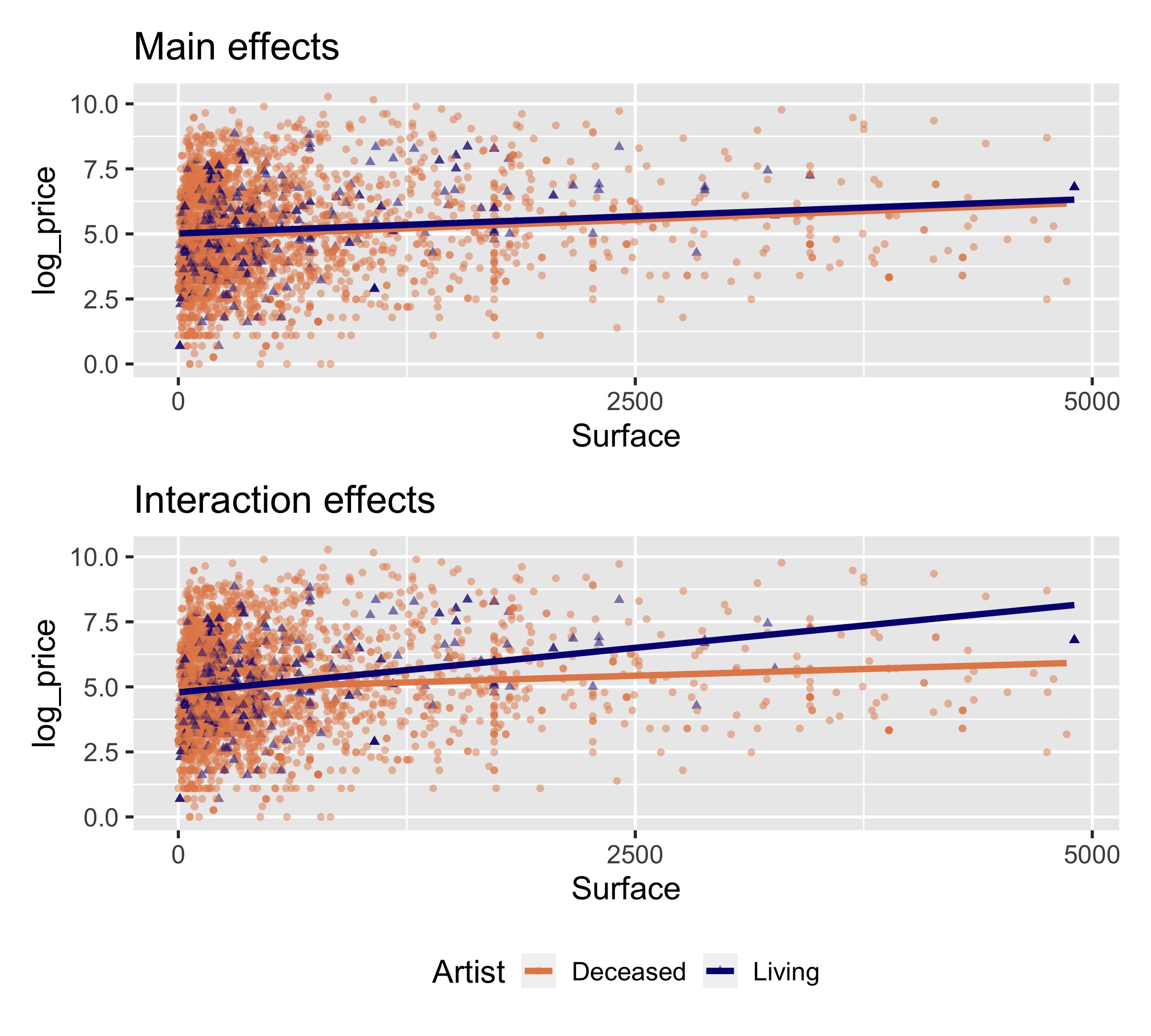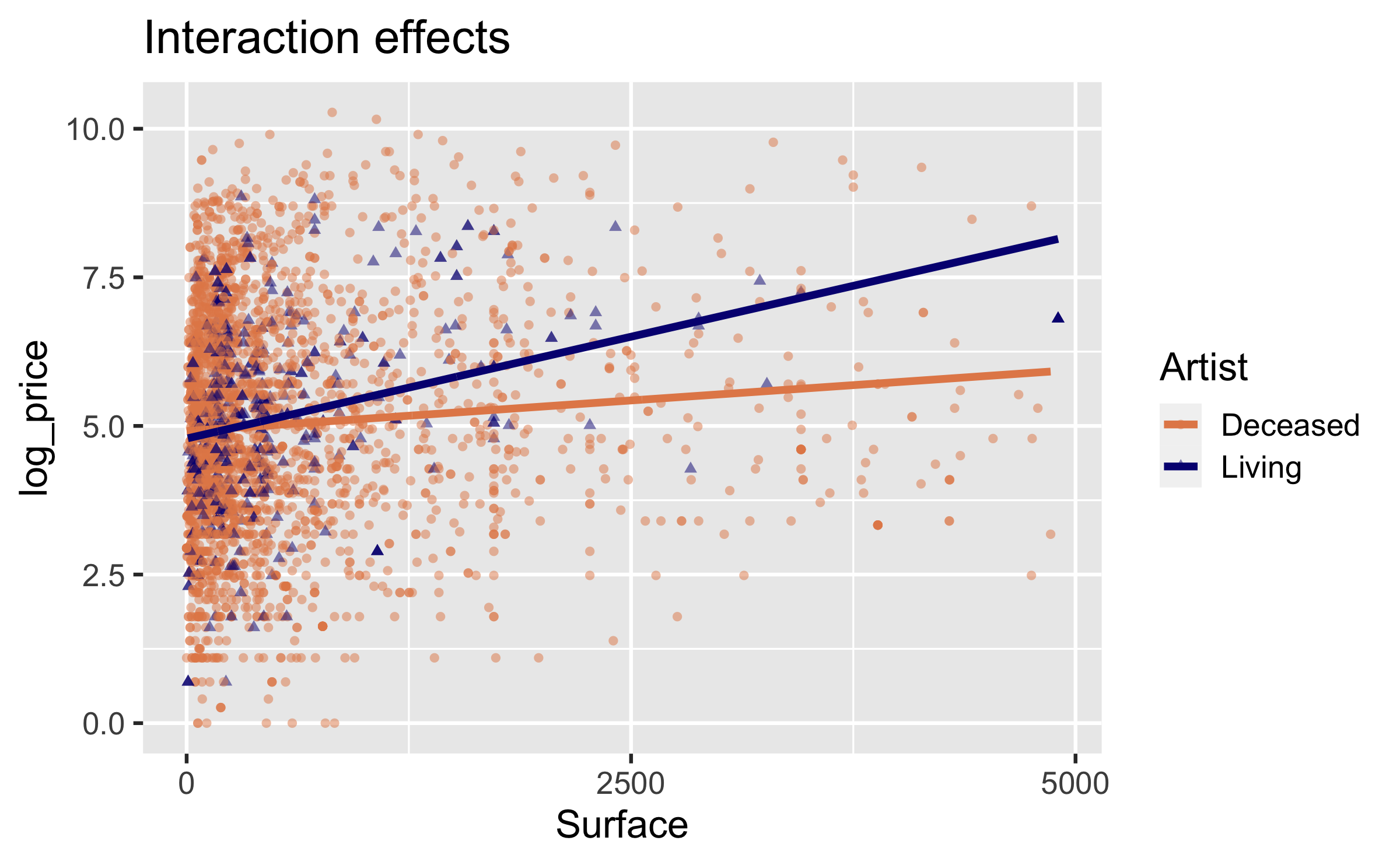The data
pp <- read_csv( "data/paris-paintings.csv", na = c("n/a", "", "NA")) %>% mutate(log_price = log(price))Multiple predictors
- Response variable:
log_price - Explanatory variables: Width and height
pp_fit <- linear_reg() %>% set_engine("lm") %>% fit(log_price ~ Width_in + Height_in, data = pp)tidy(pp_fit)## # A tibble: 3 × 5## term estimate std.error statistic p.value## <chr> <dbl> <dbl> <dbl> <dbl>## 1 (Intercept) 4.77 0.0579 82.4 0 ## 2 Width_in 0.0269 0.00373 7.22 6.58e-13## 3 Height_in -0.0133 0.00395 -3.36 7.93e- 4Linear model with multiple predictors
## # A tibble: 3 × 5## term estimate std.error statistic p.value## <chr> <dbl> <dbl> <dbl> <dbl>## 1 (Intercept) 4.77 0.0579 82.4 0 ## 2 Width_in 0.0269 0.00373 7.22 6.58e-13## 3 Height_in -0.0133 0.00395 -3.36 7.93e- 4ˆlog_price=4.77+0.0269×width−0.0133×height
Visualizing models with multiple predictors
p <- plot_ly(pp, x = ~Width_in, y = ~Height_in, z = ~log_price, marker = list(size = 3, color = "lightgray", alpha = 0.5, line = list(color = "gray", width = 2))) %>% add_markers() %>% plotly::layout(scene = list( xaxis = list(title = "Width (in)"), yaxis = list(title = "Height (in)"), zaxis = list(title = "log_price") )) %>% config(displayModeBar = FALSE)frameWidget(p)Price, surface area, and living artist
- Explore the relationship between price of paintings and surface area, conditioned on whether or not the artist is still living
- First visualize and explore, then model
- But first, prep the data
pp <- pp %>% mutate(artistliving = if_else(artistliving == 0, "Deceased", "Living"))pp %>% count(artistliving)## # A tibble: 2 × 2## artistliving n## <chr> <int>## 1 Deceased 2937## 2 Living 456Typical surface area
Typical surface area appears to be less than 1000 square inches (~ 80cm x 80cm). There are very few paintings that have surface area above 5000 square inches.

ggplot(data = pp, aes(x = Surface, fill = artistliving)) + geom_histogram(binwidth = 500) + facet_grid(artistliving ~ .) + scale_fill_manual(values = c("#E48957", "#071381")) + guides(fill = "none") + labs(x = "Surface area", y = NULL) + geom_vline(xintercept = 1000) + geom_vline(xintercept = 5000, linetype = "dashed", color = "gray")## Warning: Removed 176 rows containing non-finite values## (stat_bin).Narrowing the scope
For simplicity let's focus on the paintings with Surface < 5000:

pp_Surf_lt_5000 <- pp %>% filter(Surface < 5000)ggplot(data = pp_Surf_lt_5000, aes(y = log_price, x = Surface, color = artistliving, shape = artistliving)) + geom_point(alpha = 0.5) + labs(color = "Artist", shape = "Artist") + scale_color_manual(values = c("#E48957", "#071381"))Facet to get a better look

ggplot(data = pp_Surf_lt_5000, aes(y = log_price, x = Surface, color = artistliving, shape = artistliving)) + geom_point(alpha = 0.5) + facet_wrap(~artistliving) + scale_color_manual(values = c("#E48957", "#071381")) + labs(color = "Artist", shape = "Artist")Two ways to model
- Main effects: Assuming relationship between surface and logged price does not vary by whether or not the artist is living.
- Interaction effects: Assuming relationship between surface and logged price varies by whether or not the artist is living.
Interacting explanatory variables
- Including an interaction effect in the model allows for different slopes, i.e. nonparallel lines.
- This implies that the regression coefficient for an explanatory variable would change as another explanatory variable changes.
- This can be accomplished by adding an interaction variable: the product of two explanatory variables.
Two ways to model
- Main effects: Assuming relationship between surface and logged price does not vary by whether or not the artist is living
- Interaction effects: Assuming relationship between surface and logged price varies by whether or not the artist is living

Fit model with main effects
- Response variable:
log_price - Explanatory variables:
Surfacearea andartistliving
pp_main_fit <- linear_reg() %>% set_engine("lm") %>% fit(log_price ~ Surface + artistliving, data = pp_Surf_lt_5000)tidy(pp_main_fit)## # A tibble: 3 × 5## term estimate std.error statistic p.value## <chr> <dbl> <dbl> <dbl> <dbl>## 1 (Intercept) 4.88 0.0424 115. 0 ## 2 Surface 0.000265 0.0000415 6.39 1.85e-10## 3 artistlivingLiving 0.137 0.0970 1.41 1.57e- 1Fit model with main effects
- Response variable:
log_price - Explanatory variables:
Surfacearea andartistliving
pp_main_fit <- linear_reg() %>% set_engine("lm") %>% fit(log_price ~ Surface + artistliving, data = pp_Surf_lt_5000)tidy(pp_main_fit)## # A tibble: 3 × 5## term estimate std.error statistic p.value## <chr> <dbl> <dbl> <dbl> <dbl>## 1 (Intercept) 4.88 0.0424 115. 0 ## 2 Surface 0.000265 0.0000415 6.39 1.85e-10## 3 artistlivingLiving 0.137 0.0970 1.41 1.57e- 1ˆlog_price=4.88+0.000265×surface+0.137×artistliving
Solving the model
- Non-living artist: Plug in 0 for
artistliving
ˆlog_price=4.88+0.000265×surface+0.137×0
=4.88+0.000265×surface
Solving the model
- Non-living artist: Plug in 0 for
artistliving
ˆlog_price=4.88+0.000265×surface+0.137×0
=4.88+0.000265×surface
- Living artist: Plug in 1 for
artistliving
ˆlog_price=4.88+0.000265×surface+0.137×1
=5.017+0.000265×surface
Visualizing main effects
- Same slope: Rate of change in price as the surface area increases does not vary between paintings by living and non-living artists.
- Different intercept: Paintings by living artists are consistently more expensive than paintings by non-living artists.

Interpreting main effects
tidy(pp_main_fit) %>% mutate(exp_estimate = exp(estimate)) %>% select(term, estimate, exp_estimate)## # A tibble: 3 × 3## term estimate exp_estimate## <chr> <dbl> <dbl>## 1 (Intercept) 4.88 132. ## 2 Surface 0.000265 1.00## 3 artistlivingLiving 0.137 1.15- All else held constant, for each additional square inch in painting's surface area, the price of the painting is predicted, on average, to be higher by a factor of 1.
- All else held constant, paintings by a living artist are predicted, on average, to be higher by a factor of 1.15 compared to paintings by an artist who is no longer alive.
- Paintings that are by an artist who is not alive and that have a surface area of 0 square inches are predicted, on average, to be 132 livres.
Main vs. interaction effects
- The way we specified our main effects model only lets
artistlivingaffect the intercept. - Model implicitly assumes that paintings with living and deceased artists have the same slope and only allows for different intercepts.
What seems more appropriate in this case?
- Same slope and same intercept for both colours
- Same slope and different intercept for both colours
- Different slope and different intercept for both colours
Fit model with interaction effects
- Response variable: log_price
- Explanatory variables:
Surfacearea,artistliving, and their interaction
pp_int_fit <- linear_reg() %>% set_engine("lm") %>% fit(log_price ~ Surface * artistliving, data = pp_Surf_lt_5000)tidy(pp_int_fit)## # A tibble: 4 × 5## term estimate std.error statistic p.value## <chr> <dbl> <dbl> <dbl> <dbl>## 1 (Intercept) 4.91e+0 0.0432 114. 0 ## 2 Surface 2.06e-4 0.0000442 4.65 3.37e-6## 3 artistlivingLiving -1.26e-1 0.119 -1.06 2.89e-1## 4 Surface:artistlivingLiving 4.79e-4 0.000126 3.81 1.39e-4Linear model with interaction effects
## # A tibble: 4 × 5## term estimate std.error statistic p.value## <chr> <dbl> <dbl> <dbl> <dbl>## 1 (Intercept) 4.91e+0 0.0432 114. 0 ## 2 Surface 2.06e-4 0.0000442 4.65 3.37e-6## 3 artistlivingLiving -1.26e-1 0.119 -1.06 2.89e-1## 4 Surface:artistlivingLiving 4.79e-4 0.000126 3.81 1.39e-4ˆlog_price=4.91+0.00021×surface−0.126×artistliving + 0.00048×surface∗artistliving
Interpretation of interaction effects
- Rate of change in price as the surface area of the painting increases does vary between paintings by living and non-living artists (different slopes),
- Some paintings by living artists are more expensive than paintings by non-living artists, and some are not (different intercept).
- Non-living artist: ˆlog_price=4.91+0.00021×surface −0.126×0+0.00048×surface×0 =4.91+0.00021×surface
- Living artist: ˆlog_price=4.91+0.00021×surface −0.126×1+0.00048×surface×1 =4.91+0.00021×surface −0.126+0.00048×surface =4.784+0.00069×surface

Comparing models
It appears that adding the interaction actually increased adjusted R2, so we should indeed use the model with the interactions.
glance(pp_main_fit)$adj.r.squared## [1] 0.01258977glance(pp_int_fit)$adj.r.squared## [1] 0.01676753Third order interactions
- Can you? Yes
- Should you? Probably not if you want to interpret these interactions in context of the data.
